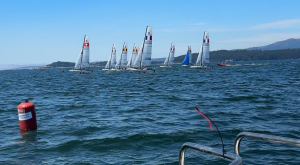The 2024 Junior World Championship was used to test two concepts for 2025-2028 racing. One is the Vakaros Race Sense starting system, which puts a fancy GPS based device on each boat and each end of the start line to aid race officers in making start line decisions. The other was to test reaching starts with the aim of using them for some racing in the Nacra 17 regular circuit.
Four races were scheduled for Day 3 of the championship, each one lap at a target time of 15 minutes. The format an adjustment from normal, to get a fuller test of reaching starts, while managing the fatigue levels of the sailors in a nod to safety. The parameters given to the RC were to run races in conditions of 8-16 knots, to ensure a minimum amount of wind to foil, and not push the upper limit too much. The wind conditions were initially so light the RC was going to set up for windward-leeward racing, but the wind built to the 8 knots so the RC went ahead with reaching starts from the first race.
The start line was set generously long at 190 meters for 12 boats, with a 5 degree bias to the leeward end and 290 meters to the first mark. We also used two start marks as a safety measure, so if teams ended up hitting either end of the line at high speed there would not be anything hard there for them to hit, nor any humans.
Race 1
The first race was relatively low wind, and teams opted to start near the windward end of the line to a deeper angle to mark one. One team put up their spinnaker pre-start, but had trouble managing it with the traffic and were late to the line. In general, the fleet was quite conservative with their starts, as one might expect with a new format at U flag flying.
The Swiss ended up foiling and charging at the line. They did a bit of a speed wobble to slow down with 5 seconds to go and managed to time their start just about perfectly. Below is a photo timestamped to ‘go’ (0:00:00) and then below that is the video to show how that timestamp was generated. The Vakaros system and RC both called the line all clear.

The feedback from this start was that some teams and some coaches thought boats were over the line. Perhaps there was an issue with flags and/or horns, but using the Vakaros timer made it pretty clear to all those overseeing the race that it was a clear start.
Race 2
Race 2 was a bit windier, and teams were a bit closer to the line, but ultimately all clear by an easy margin. Video a bit grainy but here it is:
Race 3
In this race we see our first OCS call with a French team at the windward end of the line, and also our closest call with the team right at the leeward end of the line.
The Vakaros unit called the one boat up the line OCS, and they retired, and all other boats clear. Obviously, the boat nearest to the leeward end was very close, and at the time of ‘go’ you can see them splashing down, stuttering, and then leaping forward ‘simultaneously’ with the start mark. Everyone on board thought it was close, but since the Vakaros unit said they were behind the line we opted to stick with that as the arbitrator. Note that this video point of view is not great, as the RC boat was out of alignment with the two buoys due to the cross current. While that is an issue for us to solve in general, the Race Officer was on a rib an inline with the two buoys, but this video is from the RC boat.
What is important here, is that the Vakaros system will not be perfect. It will be perfect on time, but have a small variation in location (30-50cm) in a normal distribution around the unit location.
As an observer of all starts the system was used for in the whole regatta, I can say there was no time when I thought humans could do a better job. It’s simply an impossible task to get time perfect, and edjudicate accurately between a dozen boats all crossing an imaginary line within a couple of seconds. As a sport, we’re much better off using this electronic tool as the main basis for line calls, with an experience Race Officer overseeing the global race decisions and checking for major errors.
Race 4
Race 4 was the best start of the day as more of the fleet seemed to be getting comfortable with the reaching starts, and it was a bit easier as there was a bit more wind. The start was all clear, with a fairly tight bunch who stayed pretty tight all the way down to the gates. One person commented that downwind speeds might be closer than upwind VMG, making for tight rounding at the leeward gate in this format. It could also be that with a 40s reach and then a 4 minute downwind, the fleet is still close due to it being the early stage of the race.
Here is overhead video from the day. Unfortunately the drone wasn’t there for race 1, then was late for the start of race 2, then the media boat broke down on the lead in to race 3… so we don’t have any of the start on video properly, but we do have some nice action shots.
Tracking Data
After the day, Doug from Vakaros manually downloaded all of the files and then uploaded them to a tracking display software. A couple important points:
- OCS boats are deleted by this software, so the boat that was over in race 3 does not continue to show
- The software does not include the offset and shape of the Nacra 17 (or 49er). So all we can do is set the length of the boat and the softward assumes the unit is in the middle point of the boat. That’s not how the Vakaros system works, just how this display software works.



